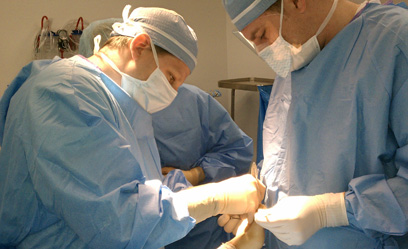Surgery In Allentown

Your PA Foot and Ankle Associates Podiatric Surgeon has been intensively trained to understand and diagnose the complex interaction, disorders, and deformities of the foot, ankle, and lower leg. We use only the most appropriate surgical and non-surgical treatments to alleviate your pain and discomfort.
What Does a Foot and Ankle Surgeon Do?
Foot and ankle (podiatric) surgeons help chronic wounds heal to prevent amputation; treat heel pain; reconstruct joints; repair and treat deformities; treat diabetic foot disorders; perform limb salvage; perform total ankle replacement; repair trauma injuries (fractures, sprains, and torn tissue); treat pediatric foot and ankle conditions; alleviate the effects of arthritis; treat nerve disorders; perform amputation when necessary; and treat many other conditions. They are the best qualified medical professionals to determine when surgical intervention for your foot and ankle condition may be appropriate.
When is Foot Surgery Necessary?
In some cases, foot problems do not respond to conservative, non-invasive treatments, and when pain or deformity persist, surgery may be necessary to alleviate your discomfort or to restore the function of your foot. Some surgeries are minimally invasive, performed in an outpatient hospital setting, and others require a hospital stay.
These are the most common types of surgery we perform:
Bunions
A bunion is a common deformity of the metatarsophalangeal(MTP) joint at the base of the big toe. It occurs when the first metatarsal bone (the longest bone of the foot) turns outward and the big toe points in toward the other toes, causing the joint to protrude and become stiff, inflamed, and painful. Wearing shoes can become unbearable.
Heredity frequently plays a role in the occurrence of bunions, as it does in many foot conditions. If conservative care fails to reduce these symptoms, surgical intervention may be warranted. Your podiatric physician will determine the type of bunion procedure best suited to repair your bunion, based on criteria like X-rays, gait examination, appearance, and your level of discomfort.
Hammertoes
Hammertoe(s) is a deformity of the second, third, or fourth toes. Caused by an imbalance in the tendon or joints of the toes, the affected toe is bent at the middle joint into an upward position, causing it to resemble a hammer.
Due to the “buckling” effect of the toe(s), hammertoes may become extremely painful and make wearing footwear uncomfortable. Corns and calluses may develop as a hammertoe becomes more rigid over time and the inside of the shoe rubs against the toes. Hammertoes frequently become inflexible and require surgery.
Your podiatric surgeon may suggest correction of this deformity through a surgical procedure to realign the toe(s).
Neuroma
Morton’s Neuroma is a painful condition affecting the ball of the foot. The result of an injury to the nerve between the toes, a section of the nerve thickens, producing pain. It most often affects the nerve that travels between the third and fourth toes.
Several factors may contribute to the formation of a neuroma: trauma, arthritis, wearing high-heeled shoes too often, and abnormal bone structure. Symptoms such as burning, numbness, or tingling in the ball of the foot or in the adjacent toes are commonly seen with this condition.
Your podiatric surgeon will initially suggest a non-invasive treatment plan. If conservative treatment does not relieve the symptoms, surgical treatment may be recommended.
Read more about Morton’s Neuroma
Bunionette (Tailor’s Bunion)
A smaller version of a typical bunion, a Tailor’s Bunion, or “bunionette” is a protuberance of bone at the outside of the foot behind the fifth (small) toe.
A bunionette has a number of causes, particularly heredity, faulty biomechanics, or trauma. Pain frequently accompanies this deformity, making shoes very uncomfortable to wear and even more difficult to walk in.
If conservative treatments fail to improve your bunionette symptoms, your podiatric surgeon may suggest a surgical procedure.
Read more about Tailor’s bunion
Bone spurs / Heel spurs
A bone spur is a bony growth that forms along the edge of normal bone in response to wear and tear, most frequently in the joints. When appearing in the heel (heel spur), it causes heel pain by rubbing on the achilles tendon or other soft tissues.
This extra bone can cause pain and restrict the motion of a joint, depending on its location and size. Spurs may also appear under the toenail plate, causing nail deformity and pain.
Surgical treatment and procedure is based on the size, location, and symptoms of the bone spur. Your podiatric surgeon will determine the surgical method best suited for your condition.
Read more about bone spurs and heel spurs
Preoperative Testing and Care
As with anyone facing any surgical procedure, those undergoing foot and ankle surgery require specific diagnostic tests or examinations before surgery to insure a successful outcome. Prior to surgery, we will review your medical history and medical conditions. Specific diseases, illnesses, allergies, and current medications need to be evaluated. Other tests that help evaluate your health status may be ordered, such as blood studies, urinalysis, EKG, MRI, X-rays, a blood flow study (to better evaluate the circulatory status of the foot/legs), or a biomechanical examination. A consultation with another medical specialist may be advised, depending on your test results or a specific medical condition.
Postoperative Care
The specifics of your postoperative care depend on the type of foot surgery you undergo. We make every effort to insure that your recovery from surgery is safe and uneventful. It’s our aim to get you back on your feet and back to your regular routine as quickly as possible.
The basics of all postoperative care involve to some degree rest, ice, compression, and elevation. Bandages, splints, surgical shoes, casts, crutches, or canes may be necessary to improve and ensure a safe recovery after foot surgery. Your successful recovery can be hastened by carefully following the instructions from your podiatric surgeon.


